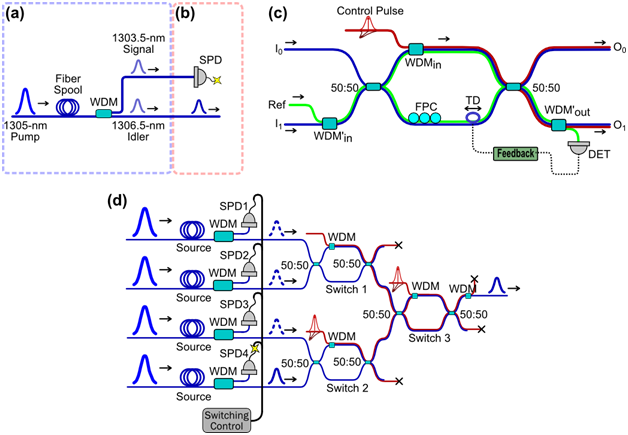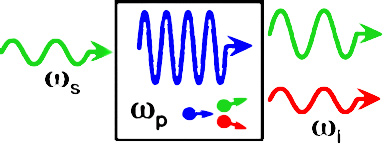Single-photon signals can be used to complete a variety of computing and communications tasks better than the best known methods which rely on traditional laser pulses. Unfortunately, the single-photon sources demonstrated to date are either very low rate or very inefficient. The goal of this project is to multiplex the outputs of four inefficient, simultaneously pumped, heralded, single-photon sources using a low-loss, all-optical, quantum switch network to generate single photons at an increased rate. This work is sponsored by the DARPA InPho program and the NASA Space Technology Research Fellowship program.

(a) Schematic of a fiber-based, heralded, single-photon source. A strong 1305-nm pump pulse propagates through a long spool of fiber, undergoes spontaneous four wave mixing (SFWM), and creates a pair of correlated photons called signal and idler at 1303.5 nm and 1306.5 nm, respectively. The correlated photons are isolated using a wavelength division multiplexer (WDM). (b) Because the SFWM process is inefficient, the signal photon is directed to a single-photon detector (SPD). If the SPD measures the signal photon, then the existence of the idler photon is confirmed. This type of source generally “heralds” the signal photon with a probability of ~1% per pump pulse. (c) A two-input (I0, I1), two-output (O0, O1), all-optical, low-loss (0.37 dB), quantum switch. The Mach-Zehnder interferometer (MZI) based device is configured such that a ~1310-nm photonic quantum signal input to I0 (I1) is routed to O0 (O1). When a strong control pulse is multiplexed into the MZI via WDMin, it interacts with the co-propagating signal amplitude via cross-phase modulation (XPM) and transposes the input-output mapping of the device. The MZI is phase stabilized by injecting a weak reference field (Ref) in I1 via WDM’in, picking it off O1 via WDM’out, detecting the signal, and feeding back to a tunable delay in one arm of the MZI. Any change in MZI phase results in a change in the measured Ref signal, and the feedback mechanism adjusts the length of one arm to counteract the change in phase.(d) Pumping multiple heralded sources simultaneously increases the chance that a photon is heralded. The goal of this project is to construct a proof-of-principle, two-stage, quantum switch network that multiplexes the outputs of four heralded sources into a single output. The behavior of the switch network will be conditional on the signals generated by the heralding detectors, so that if a photon is created it is routed to the device output.

